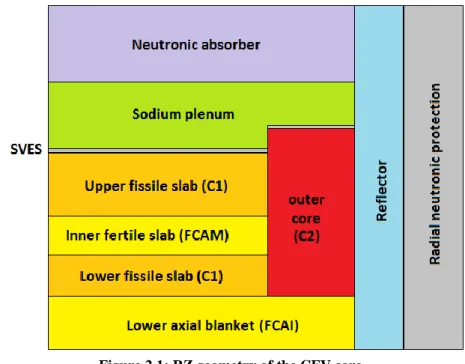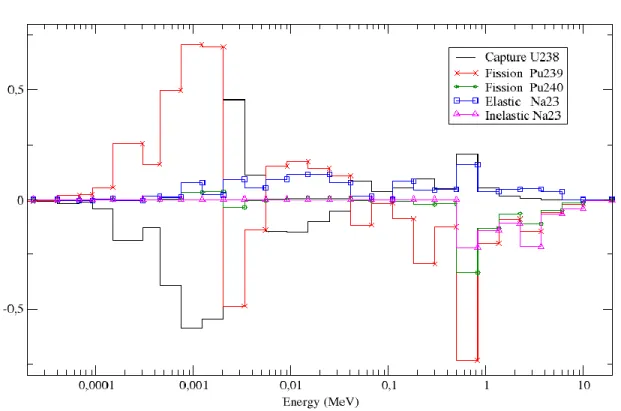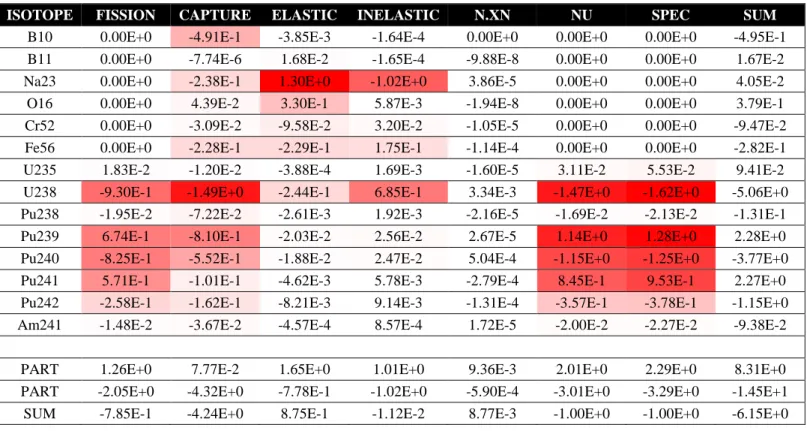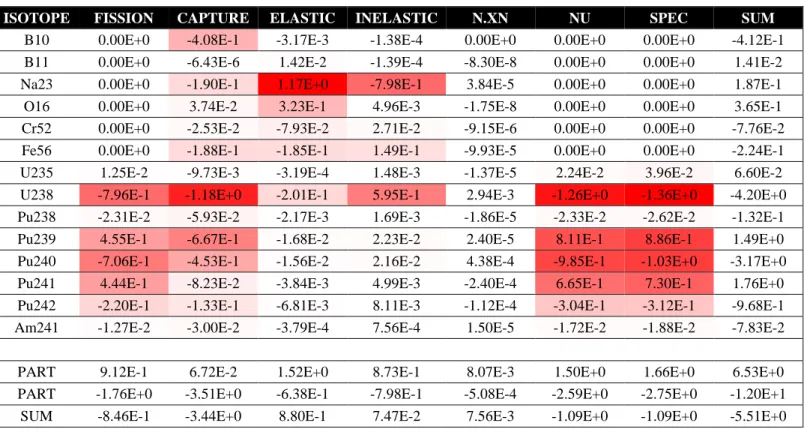HAL Id: hal-02416227
https://hal.archives-ouvertes.fr/hal-02416227
Submitted on 17 Dec 2019HAL is a multi-disciplinary open access archive for the deposit and dissemination of sci-entific research documents, whether they are pub-lished or not. The documents may come from teaching and research institutions in France or abroad, or from public or private research centers.
L’archive ouverte pluridisciplinaire HAL, est destinée au dépôt et à la diffusion de documents scientifiques de niveau recherche, publiés ou non, émanant des établissements d’enseignement et de recherche français ou étrangers, des laboratoires publics ou privés.
uncertainties on the astrid sodium void reactivity effect
P. Dufay, G. Rimpault
To cite this version:
P. Dufay, G. Rimpault. a new approach for analysing the impact of nuclear data uncertainties on the astrid sodium void reactivity effect. PHYSOR 2018 Reactors Physics paving the way towards more efficient systems, Apr 2018, Cancun, Mexico. �hal-02416227�
A NEW APPROACH FOR ANALYSING THE IMPACT OF NUCLEAR
DATA UNCERTAINTIES ON THE ASTRID SODIUM VOID REACTIVITY
EFFECT
Authors : DUFAY Paul 1 and RIMPAULT Gérald 1
1
CEA Cadarache, DEN/CAD/DER/SPRC/LEPh, 13108 Saint Paul Lès Durance paul.dufay@cea.fr, gerald.rimpault@cea.fr
ABSTRACT
For ensuring sustainable nuclear energy, France has chosen to develop sodium cooled fast reactors. The ASTRID project is a demonstrator of such technology exhibiting innovative features such as the CFV core which has a negative sodium void reactivity effect. In order to study in details the uncertainty associated to this parameter, we split it into two components : the central component (CC) which is a positive reactivity effect due to spectrum changes and the leakage component (LC) which is a negative reactivity effect due to the increase of the neutron mean free path. This paper presents the development of an innovative GPT procedure for computing sensitivities of the CC and the LC. With such sensitivities and the use of the COMAC-V2 covariance matrix, we are able to calculate the uncertainties due to nuclear data on each component using JEFF-3.2 nuclear data. The application of the method to the ASTRID CFV core shows a 2.44% uncertainty on the CC, a 2.98% uncertainty on the LC and a 14.8% on the total sodium void reactivity effect. There is a correlation factor of -0.5776 between the LC and CC uncertainties. This approach gives perspectives in studying experimental programmes performed in zero power facilities such as MASURCA.
KEYWORDS: Sodium Void Reactivity Effect, GPT, ASTRID, nuclear data sensitivities and uncertainties.
1 INTRODUCTION
The future of nuclear energy involves the development of the 4th generation of nuclear reactors such as Sodium cooled Fast Reactors (SFR). These reactors have to implement an enhanced safety but they also have to burn radioactive waste like Plutonium, one of the main contributors to radiotoxicity. Furthermore using the whole uranium ore as a fuel ensures the sustainability of this energy which is one of the main concerns of this century. France has chosen to build an advanced demonstrator of SFR technology, the so-called ASTRID reactor (which stands for Advanced Sodium Technological Reactor for Industrial Demonstration). This design is built on the “CFV core” which is designed to get a negative sodium void reactivity effect. In case of loss of coolant the number of neutrons leaking out of the core increases and the energy spectrum becomes harder; these two antagonistic effects are part of the sodium void reactivity effect. Each effect is affected by nuclear data uncertainties and needs to be calculated precisely. In this paper, we present a way to get the sensitivity of each component to nuclear data and hence uncertainties
2 The ASTRID CFV core 2.1 The ASTRID CFV core lay out
The Advanced Sodium Technological Reactor for Industrial Demonstration (ASTRID)[1] project aims at building a sodium fast demonstrator in the next ten years. An innovative core design has been selected by CEA: the so-called “CFV core”. These innovations, concerning the geometry, have been conceived to ensure the natural shutdown of the chain reaction in case of loss of coolant. In this accidental situation the energy spectrum of neutrons is harder because they are not anymore scattered on sodium nuclei. Furthermore a harder spectrum means that neutrons production by fission is increased. The associated reactivity effect is positive and is defined as the central component. However the total cross section is decreased allowing more neutrons to leak out of the core, this negative reactivity effect is the leakage component and it has to be greater than the central component for safety reasons. The CFV core has four major innovations to get the highest leakage component in case of sodium void: an outer core higher than the inner core, a fertile slab in the inner core, a plenum sodium on the core and neutronic absorber on the plenum sodium (see figure 2.1).
.
Figure 2.1: RZ geometry of the CFV core
2.2 The sodium void reactivity effect in ASTRID CFV core
The sodium void reactivity effect is breakdown into a central component and a leakage component. ∆ρNa= CC + LC
ASTRID core design exhibits very innovative features compared to past reactors (such as Super-Phénix). The ASTRID core is very heterogeneous [2] and achieves negative sodium void reactivity effect through the existence of a large leakage component (Table 2.1). Sodium void reactivity effect are measured in $ which is the reactivity difference normalised by the effective delayed neutron fraction.
Table 2.1: Break down of sodium void reactivity effect in the ASTRID CFV core with JEFF-3.2 Void Effect Central Component Leakage component
∆𝛒𝐍𝐚 (pcm, $) -550 (-1.4$) 2773 (7.1$) -3323 (-8.5$)
The ERANOS code system makes use of the effective cross sections produced by the ECCO cell code (P1 consistent order 1 approximation) to perform full reactor calculations. To determine these two components, perturbation calculations were performed using the ERANOS code system with transport theory (S8 P1 approximation). The separation of the leakage and the non-leakage components of the reactivity worth in transport theory is performed in the following way :
LC = ∑ δΣg tg((4π12)∫ Ψ4π gdΩ⃗⃗ ∫ Ψ4π g+dΩ⃗⃗ −4π1 ∫ Ψ4π gΨg+dΩ⃗⃗ )+high order scattering terms. 2.1
where Ψg and Ψg+ are respectively the direct and adjoint angular fluxes. The leakage component is
negative and takes into account the increase of the mean free path of neutrons when the core is voided.
The central component is the sum of physical variations: capture, fission, spectrum, elastic removal, inelastic removal and n,xn removal which are globally positive. It can be calculated directly using the scalar direct and adjoint fluxes.
Table 2.2: Breakdown of sodium void reactivity effect by reaction and by domain in the ASTRID CFV core with JEFF-3.2 (in pcm)
Domain Capture Fission Spectrum Leakage Elastic Inelastic N,XN Sum
C1 135.5 3.9 6.7 -358.7 535.4 416.6 -0.3 739.1 C2 129.2 -0.2 4.4 -367.3 350.8 270.8 -0.2 387.5 FCAM 39.3 -0.5 -0.2 -40.0 282.7 86.2 0.0 367.4 FCAI 0.0 0.0 0.0 -0.1 1.6 0.2 0.0 1.6 FCALE 1.6 0.0 0.0 -33.9 6.6 3.5 0.0 -22.1 SVES 4.0 0.0 0.0 -224.0 32.2 14.9 0.0 -172.9 PLENUM 20.4 0.0 0.0 -2299.4 325.4 103.3 0.0 -1850.2 Sum 330.0 3.2 10.9 -3323.5 1534.8 895.6 -0.5 -549.6
3 Sensitivity of the sodium void reactivity effect to nuclear data In the following parts the notations used are for integrals on space, energy and angle:
〈 f 〉 = ∫ d3r V ∫ d2Ω 4π ∫ dE∞ 0 f(r , Ω⃗⃗ , E) 3.1 ⟨ f | g ⟩ = ∫ d3r V ∫ d2Ω 4π ∫ dE∞ 0 f(r , Ω⃗⃗ , E) g(r , Ω⃗⃗ , E) 3.2 We define also two operators: 𝐀 the transport, removal and scattering operator and 𝐅 the fission source operator. In a critical system we get the neutron flux and his adjoint flux with the forward and adjoint Boltzmann equations 3.3.
(𝐀 −𝐅
k) Φ = 0 and (𝐀+− 𝐅+
3.1 Sensitivities to nuclear data
The sensitivity of a given parameter P to a nuclear data σ, such as a microscopic section or an energy spectrum, is: S(P, σ) =dP P dσ σ ⁄ 3.4
The sensitivity of the reactivity to nuclear data S(ρ, σ) can be obtained with the exact Standard Perturbation Theory (SPT) formula (see 3.5) which gives the reactivity variation between the nominal state (noted “n”) and the perturbed state (noted “p”):
dρ =dk k² = − ⟨Φn+| (d𝐀 n−d𝐅kn n) Φn p⟩ ⟨Φn+|𝐅Φ n p⟩ 3.5
The reactivity variation is related to the multiplication factor k with: ρ = 1 −k
k meaning that : dρ
ρ = dk
k(k−1). Furthermore the operators (𝐀 and 𝐅) of the Boltzmann equation vary linearly with nuclear data so
the derivation of the operators is restricted to the considered nuclear data σ.
S(ρ, σ) =dρ ρ dσ σ ⁄ = − k k − 1 ⟨Φn+| (d𝐀 n−d𝐅kn n)σΦn p⟩ ⟨Φn+|𝐅Φ n p⟩ 3.6
3.2 The EGPT method to calculate the sensitivity of the total sodium void reactivity effect
The sodium void reactivity effect is the difference between the nominal reactivity (n) and the voided (v) configuration reactivity ∆ρ = ρv− ρn. In order to vary this reactivity effect we can use twice the exact SPT formula which perturbs the two configurations as follow:
d(∆ρ) = dρv− dρn= −⟨Φv +| (d𝐀 v−d𝐅kv v) Φv p⟩ ⟨Φv+|𝐅Φvp⟩ +⟨Φn +| (d𝐀 n−d𝐅kn n) Φn p⟩ ⟨Φn+|𝐅Φnp⟩ 3.7 With : d𝐀i= 𝐀pi − 𝐀i and d𝐅i= 𝐅ip− 𝐅i , i ∈ {n, v}.
This formula is called the first order Equivalent Generalised Perturbation Theory (EGPT). Using twice the SPT is much easier to implement in neutronic code than applying the Generalised Perturbation Theory (GPT) on the sodium void reactivity effect (which would have been exact) that is why it is called “equivalent”. The results of the EGPT applied to sodium void reactivity effect in the ASTRID core are given in the following table 3.1.
Table 3.1 : Sensitivities (%/%) of the total sodium void reactivity effect to nuclear data with JEFF-3.2
Isotope Fission Capture Elastic Inelastic N,xN Nu Spectrum Sum
B10 0.00E+0 -4.91E-1 -3.85E-3 -1.64E-4 0.00E+0 0.00E+0 0.00E+0 -4.95E-1 B11 0.00E+0 -7.74E-6 1.68E-2 -1.65E-4 -9.88E-8 0.00E+0 0.00E+0 1.67E-2 Na23 0.00E+0 -2.38E-1 1.30E+0 -1.02E+0 3.86E-5 0.00E+0 0.00E+0 4.05E-2 O16 0.00E+0 4.39E-2 3.30E-1 5.87E-3 -1.94E-8 0.00E+0 0.00E+0 3.79E-1 Fe56 0.00E+0 -2.28E-1 -2.29E-1 1.75E-1 -1.14E-4 0.00E+0 0.00E+0 -2.82E-1 U238 -9.30E-1 -1.49E+0 -2.44E-1 6.85E-1 3.34E-3 -1.47E+0 -1.62E+0 -5.06E+0 Pu238 -1.95E-2 -7.22E-2 -2.61E-3 1.92E-3 -2.16E-5 -1.69E-2 -2.13E-2 -1.31E-1 Pu239 6.74E-1 -8.10E-1 -2.03E-2 2.56E-2 2.67E-5 1.14E+0 1.28E+0 2.28E+0 Pu240 -8.25E-1 -5.52E-1 -1.88E-2 2.47E-2 5.04E-4 -1.15E+0 -1.25E+0 -3.77E+0 Pu241 5.71E-1 -1.01E-1 -4.62E-3 5.78E-3 -2.79E-4 8.45E-1 9.53E-1 2.27E+0 Pu242 -2.58E-1 -1.62E-1 -8.21E-3 9.14E-3 -1.31E-4 -3.57E-1 -3.78E-1 -1.15E+0 SUM -7.85E-1 -4.24E+0 8.75E-1 -1.12E-2 8.77E-3 -1.00E+0 -1.00E+0 -6.15E+0 The mains contributors to the sensitivity of the total sodium void reactivity effect are the capture, fission, spectrum and nu contribution of U238, Pu240 and Pu239 which are the main isotopes of the ASTRID fuel (with low quality Plutonium) then the spectrum effect have an important impact on these isotopes cross sections. Obviously elastic and inelastic cross sections of Na23 are also big contributors to the sensitivity.
3.3 The GPT method to calculate the sensitivity of the central component
The GPT allows to calculate exactly the sensitivity of others parameters than reactivity or multiplication factor to nuclear data, for instance using GPT [3], we can compute the sensitivity of reaction rate, reaction rate ratio, etc. The central component is the sum of the variation between the nominal and the voided configuration of different physical components: the capture, the fission, the production, the spectrum, the scattering removal (elastic plus inelastic plus “n,xn” removal). In ERANOS [4] [5] the energy range is breakdown into 33 groups of energy, for each group “g” the physical components are weighed by the adjoint flux as follow:
Capture Ccg= −δΣcg. ∫ Φg+. ΦgdV V 3.8 Fission Cfg= −δΣfg. ∫ Φg+. ΦgdV V + δ(νΣfg). ∫ Φg∑ χgΦg′+ g′ dV V 3.9 Production Cνg= δ(νΣf g ). ∫ Φg∑ χgΦg′+ g′ dV V 3.10 Spectrum Cspecg = δ𝜒𝑔∫ Φg+. ∑ νΣf g′ Φg′ g′ dV V 3.11 Scattering Cscattg = ∑ δΣscattg→g′
g′ (∫ Φg′+. ΦgdV V − ∫ Φg+. ΦgdV V ) 3.12
This sum of physical component is a reactivity variation and GPT can be applied in this case to compute the sensitivity of the CC to nuclear data : S(CC) = dCC
CC dσ
σ
⁄ . The derivation of the CC (function of nuclear data σ , the flux Φ and adjoint flux Φ+) is done using two Lagrange multipliers Ψ et Ψ+ (called generalised importances functions), we get the variation of the functional T defined as follow :
T = ln(CC(σ, Φ, Φ+)) − ⟨Ψ+| (𝐀 −𝐅 k)Φ⟩−⟨Ψ| (𝐀+− 𝐅+ k+)Φ +⟩ 3.13 dT =dCC CC − ⟨Ψ +| (d𝐀 −d𝐅 k)Φ⟩−⟨Ψ| (d𝐀+− d𝐅+ k+ )Φ +⟩−⟨Ψ+| (𝐀 −𝐅 k)dΦ⟩ −⟨Ψ| (𝐀+−𝐅 + k+)dΦ + ⟩−dk k2(⟨Ψ +|𝐅Φ⟩+⟨Ψ|𝐅+Φ+⟩) 3.14 With : dCCCC = 〈∂CC∂σ dσCC+∂CC∂ΦdΦCC +∂Φ∂CC+ dΦ+
CC 〉, we can group the terms in dΦ and dΦ +: dT = 〈∂CC ∂σ dσ CC〉 − ⟨Ψ +| (d𝐀 −d𝐅 k)Φ⟩−⟨Ψ| (d𝐀+− d𝐅+ k+)Φ +⟩+⟨∂CC ∂Φ dΦ CC−(𝐀+− 𝐅+ k+)Ψ +|dΦ⟩ +⟨∂CC ∂Φ+ dΦ+ CC −(𝐀 − 𝐅 k)Ψ|dΦ+⟩− dk k2(⟨Ψ +|𝐅Φ⟩+⟨Ψ|𝐅+Φ+⟩) 3.15
The terms in dΦ and dΦ+ vanish because we compute Ψ and Ψ+ such as:
(𝐀+−𝐅+ k+) Ψ+= ∂CC ∂Φ dΦ CC ⏟ S1 and (𝐀 −𝐅 k) Ψ = ∂CC ∂Φ+ dΦ+ CC ⏟ S2 3.16 The exact expression of the source S1 and S2 are given by :
S1g=−δΣc gΦ g +− δΣ f gΦ g ++ δ(υΣ f)g∑ χg′ g′Φg+′+ (υΣf)g∑ δχg′ g′Φg+′+ ∑ δΣsg→g ′ (Φg+′− Φg+) g′ 〈CC〉 3.17 S2g=−δΣc gΦ g− δΣfgΦg+ χg∑ δ(υΣg′ f)g′Φg′+ δχg∑ (υΣg′ f)g′Φg′+ ∑ δΣg′ sg′→g(Φg′− Φg) 〈CC〉 3.18
Furthermore terms in dk vanish too since Ψ and Ψ+ are not exactly defined for any scalar λ and λ+,
λΦ) and (Ψ+− λ+Φ+) are also solutions of the equations 3.16, λ and λ+ are usually chosen to make the
terms ⟨Ψ+|𝐅Φ⟩ and ⟨Ψ|𝐅+Φ+⟩ vanish. In the end we can breakdown the sensitivity into two terms: direct
and indirect. SCC =dCC dσ σ CC= σ CC ( 〈∂CC ∂σ〉 ⏟ Direct term − ⟨Ψ+| (d𝐀 dσ− 1 k d𝐅 dσ) Φ⟩ − ⟨Ψ| ( d𝐀+ dσ − 1 k d𝐅+ dσ) Φ+⟩ ⏟ Indirect term ) 3.19 3.4 Sensitivity of the LC to nuclear data for ASTRID CFV core
Once we get the sensitivity of the CC and of the total sodium void reactivity effect (using EGPT) to nuclear data we can calculate the sensitivity of the LC to nuclear data as follow:
S∆ρNa= d(∆ρNa) dσ σ ∆ρNa= d(CC + LC) dσ σ ∆ρNa= dCC dσ σ ∆ρNa+ dLC dσ σ ∆ρNa= SCC CC ∆ρNa+ SLC LC ∆ρNa 3.20 SLC= S∆ρNa ∆ρNa LC − SCC CC LC 3.21
These sensitivities (S∆ρNa, SLC, SCC) calculated with JEFF-3.2 are given in appendix A.
4 Uncertainty of the sodium void effect due to nuclear data Once sensitivities are calculated we use the Sandwich formula:
I2= St. B. S 4.1
Where: B is the dispersion matrix which is based on the covariance matrix(such as COMAC developed at CEA [6]). The covariance matrix depends on the nuclear data library used: COMAC-V0.1 for JEFF-3.1
and COMAC-V2 for JEFF3.2 [6]. This covariance matrix takes into account the covariance between all neutronic parameters for each isotope. It was established with experimental results.
4.1 The uncertainty of the total sodium void reactivity effect
Using the formula 4.1 with the sensitivities given by the EGPT method (see section 3.2) for the total sodium void reactivity we get the uncertainty due to nuclear data on the ∆ρNa of 14.8% meaning 81.41 pcm.
Table 4.1: Uncertainties (in %) of the total sodium void reactivity effect with JEFF3-2 and COMAC-V2
Isotope Fission Capture Elastic Inelastic N,xN Nu Spectrum Sum
Na23 0.00 3.10 3.05 2.29 0.01 0.00 0.00 4.92 O16 0.00 1.01 0.38 0.04 0.00 0.00 0.00 1.08 Fe56 0.00 2.40 1.14 0.41 0.00 0.00 0.00 2.68 U235 0.12 0.08 0.00 0.01 0.00 0.04 0.02 0.15 U238 1.80 4.71 0.34 3.18 0.29 0.72 0.74 6.06 Pu238 0.14 0.65 0.02 0.02 0.00 0.34 0.16 0.76 Pu239 8.94 3.47 0.10 0.10 0.01 1.37 0.68 9.71 Pu240 5.50 3.63 0.15 0.55 0.01 0.19 1.52 6.74 Pu241 1.72 1.14 0.03 0.06 0.01 0.66 0.76 2.29 Pu242 0.46 1.80 0.06 0.08 0.00 0.24 0.10 1.87 TOTAL 10.80 8.32 3.31 3.90 0.29 1.74 1.98 14.80
As expected the main contributors to the uncertainty are the fuel isotopes (Pu239 and Pu240) and fertile isotopes (U238) but also the structure material (Fe56) and coolant isotope (Na23) of course.
4.2 The uncertainty of the central component of the sodium void reactivity effect
As seen in section 3.3 and using the 3.19 equation to calculate the sensitivity of the CC to nuclear data we get an uncertainty of 2.44% on the CC of the ASTRID core when using JEFF-3.2 and COMAC-V2 i.e. an uncertainty of 67.6 pcm of the 2773 pcm CC. The main contributors to these uncertainties (Table 4.2) are the fission cross sections of Pu239, the capture, elastic and inelastic cross sections of Na23 and the inelastic cross sections of U238.
Table 4.2: Uncertainties (in %) of the CC due to nuclear data with JEFF-3.2 and COMAC-V2
Isotope Fission Capture Elastic Inelastic N,xN Nu Spectrum Sum
Na23 0.00 0.71 1.55 0.80 0.00 0.00 0.00 1.89 O16 0.00 0.12 0.28 0.00 0.00 0.00 0.00 0.31 Fe56 0.00 0.14 0.14 0.08 0.00 0.00 0.00 0.21 U235 0.01 0.03 0.00 0.00 0.00 0.00 0.01 0.04 U238 0.28 0.15 0.03 0.90 0.04 0.13 0.02 0.97 Pu238 0.02 0.04 0.00 0.01 0.00 0.15 0.14 0.21 Pu239 0.49 0.20 0.02 0.09 0.00 0.15 0.21 0.60 Pu240 0.95 0.47 0.01 0.10 0.00 0.03 0.24 0.85 Pu241 0.14 0.15 0.00 0.04 0.00 0.13 0.31 0.40 Pu242 0.05 0.10 0.00 0.03 0.00 0.03 0.03 0.12 TOTAL 1.11 0.65 1.59 1.21 0.04 0.28 0.47 2.44
The main contributors (apart from nu and spectrum) to the sensitivity of the CC are the elastic and inelastic of Na23 and O16 isotopes at high energy (see figure 4.1).
Figure 4.1: Sensitivity comparison between main contributors to CC sensitivity
4.3 The uncertainty of the leakage component of the void sodium reactivity effect
As seen in section 3.4 and using the 3.22 equation to calculate the sensitivity of the LC to nuclear data we get an uncertainty of 2.98% on the LC for the ASTRID core with JEFF-3.2 and COMAC-V2 i.e. an uncertainty of 98.9 pcm of the -3323 pcm LC. The main contributors to these uncertainties are the fission cross section of Pu239 and capture and inelastic cross sections of Na23.
Table 4.3: Uncertainties(in %) of the LC due to nuclear data with JEFF-3.2 and COMAC-V2
Isotope Fission Capture Elastic Inelastic N,xN Nu Spectrum Sum
Na23 0.00 1.11 0.78 1.05 0.00 0.00 0.00 1.71 O16 0.00 0.07 0.20 0.00 0.00 0.00 0.00 0.21 Fe56 0.00 0.49 0.27 0.05 0.00 0.00 0.00 0.56 U235 0.02 0.03 0.00 0.00 0.00 0.01 0.01 0.04 U238 0.12 0.81 0.04 0.26 0.01 0.02 0.14 0.87 Pu238 0.02 0.14 0.00 0.01 0.00 0.17 0.15 0.26 Pu239 1.72 0.65 0.04 0.06 0.00 0.29 0.29 1.89 Pu240 0.20 0.63 0.03 0.09 0.00 0.01 0.45 0.81 Pu241 0.34 0.21 0.01 0.03 0.00 0.22 0.38 0.60 Pu242 0.05 0.37 0.01 0.02 0.00 0.01 0.03 0.37 TOTAL 1.77 1.78 0.86 1.09 0.01 0.41 0.69 2.98
The fission cross section of Pu239 has high sensitivities at high energy (around 200keV-1MeV) but also at lower energies (around 1keV) see figure 4.2.
Figure 4.2: Sensitivity comparison between main contributors to LC sensitivity.
4.4 The correlation between the sensitivities of each components of the sodium void reactivity effect
The correlation between the uncertainty on one hand the CC and on the other hand the LC is calculated as follow : I∆ρ2 Na(in%) = S ∆ρNa t . B. S ∆ρNa = (SCC t CC ∆ρNa+ SLC t LC ∆ρNa) . B. (SCC CC ∆ρNa+ SLC LC ∆ρNa) 4.2 I∆ρ2 Na(in%) = ICC2 (in%) CC² ∆ρNa²+ ILC2 (in %) LC2 ∆ρNa2 + 2 SCCt . B. SLC LC × CC ∆ρNa² 4.3 I∆ρ2 Na= I CC 2 + I LC2 + 2 SCCt . B. SLC. LC. CC 4.4
This expression gives us the correlation between these uncertainties comparing to this one : I∆ρ2 Na= I CC 2 + I LC2 + 2 rCC,LC ICCILC 4.5 rCC,LC=SCC t . B. S LC. LC. CC ICCILC 4.6
This parameter rCC,LC vary between -1 to +1 and the closer to |1| the more correlated it is. Using the sensitivity calculated by GPT for the CC and the ones calculated for the LC we got : -0.5776 (with JEFF-3.2 and COMAC-V2) as correlation between the CC and the LC. Meaning that CC and LC for ASTRID core are not correlated and it justifies the historical choice to study independently the impact of CC and
LC in sodium void reactivity measurement. It will be very interesting to apply this work to past experiments where sodium void reactivity measurements were conducted (such as PRE-RACINE [7] and CIRANO [8] programmes in the MASURCA zero power facility at CEA Cadarache). This method will offer a new perspective for analysing the experimental SVRE where CC and LC have different relative contributions.
5 Conclusion
The development of an innovative procedure in ERANOS allows getting the sensitivities of each component of the total sodium void reactivity effect. For the ASTRID program this work has predicted an uncertainty of 81.4 pcm on the sodium void reactivity effect with a breakdown into an uncertainty of 67.6 pcm on the CC and 98.9 pcm on the LC. The correlation between these uncertainties is calculated as -0.5776 meaning that the independent study of each component in an experimental program is justified. Finally the same work has to be done with integral experiments where sodium void reactivity were measured such as PRE-RACINE and CIRANO program lead in the MASURCA facility at CEA Cadarache. Furthermore the high value of uncertainties due to nuclear data for ASTRID CFV core gives credit to lead a new experimental program in MASURCA with a core configuration more representative than last experiments. For instance PRE-RACINE and CIRANO programs have no plenum sodium which is an important feature of the CFV core.
REFERENCES
[1] M. Saez, J.-C. Robin, B. Riou, A. Villedieu, D. Deprest, and G. Prele, ‘Status of ASTRID nuclear island pre-conceptual design’, IAEA-CN-199, p. 127, Mar. 2013.
[2] F. Varaine et al., ‘Pre-conceptual design study of ASTRID core’, presented at the ICAPP’12, 2012. [3] J. Tommasi, ‘ERANOS user’s manual – applications of perturbation theory with finite difference
diffusion and Sn transport flux solvers’. RT 07-003 SPRC/LEPh.
[4] G. Rimpault et al., ‘The ERANOS code and data system for fast reactor neutronic analyses’, presented at the PHYSOR 2002, Seoul, KOREA, 2002.
[5] J. M. Ruggieri and al, ‘ERANOS 2.0, Modular code and data system for fast reactor neutronics analyses’. NEA-1683/01, 10-Mar-2008.
[6] P. Archier, C. De Saint Jean, G. Noguere, O. Litaize, P. Leconte, and C. Bouret, ‘COMAC: Nuclear Data Covariance Matrices Library for Reactor Applications’, presented at the PHYSOR 2014- The Role of Reactor Physics toward a Sustainable Future, Kyoto, Japan, 2014.
[7] G. Humbert et al., ‘Parametric Studies on Heterogeneous Cores for Fast Breeder Reactors: The Pre-Racine and Pre-Racine Experimental Programs’, Nucl. Sci. Eng., vol. 87, no. 3, pp. 233–251, Jul. 1984. [8] G. Rimpault, H. Oigawa, and P. Smith, ‘Assessment of latest developments in sodium void reactivity
worth calculations’, in Proc. Int. Conf. on the Physics of Reactors, Mito, Japan, 1996, vol. 2, pp. 16– 20.
APPENDIX A
Table A.1: Sensitivities of the total sodium void reactivity effect with JEFF-3.2
ISOTOPE FISSION CAPTURE ELASTIC INELASTIC N.XN NU SPEC SUM
B10 0.00E+0 -4.91E-1 -3.85E-3 -1.64E-4 0.00E+0 0.00E+0 0.00E+0 -4.95E-1
B11 0.00E+0 -7.74E-6 1.68E-2 -1.65E-4 -9.88E-8 0.00E+0 0.00E+0 1.67E-2
Na23 0.00E+0 -2.38E-1 1.30E+0 -1.02E+0 3.86E-5 0.00E+0 0.00E+0 4.05E-2
O16 0.00E+0 4.39E-2 3.30E-1 5.87E-3 -1.94E-8 0.00E+0 0.00E+0 3.79E-1
Cr52 0.00E+0 -3.09E-2 -9.58E-2 3.20E-2 -1.05E-5 0.00E+0 0.00E+0 -9.47E-2
Fe56 0.00E+0 -2.28E-1 -2.29E-1 1.75E-1 -1.14E-4 0.00E+0 0.00E+0 -2.82E-1
U235 1.83E-2 -1.20E-2 -3.88E-4 1.69E-3 -1.60E-5 3.11E-2 5.53E-2 9.41E-2
U238 -9.30E-1 -1.49E+0 -2.44E-1 6.85E-1 3.34E-3 -1.47E+0 -1.62E+0 -5.06E+0
Pu238 -1.95E-2 -7.22E-2 -2.61E-3 1.92E-3 -2.16E-5 -1.69E-2 -2.13E-2 -1.31E-1
Pu239 6.74E-1 -8.10E-1 -2.03E-2 2.56E-2 2.67E-5 1.14E+0 1.28E+0 2.28E+0
Pu240 -8.25E-1 -5.52E-1 -1.88E-2 2.47E-2 5.04E-4 -1.15E+0 -1.25E+0 -3.77E+0
Pu241 5.71E-1 -1.01E-1 -4.62E-3 5.78E-3 -2.79E-4 8.45E-1 9.53E-1 2.27E+0
Pu242 -2.58E-1 -1.62E-1 -8.21E-3 9.14E-3 -1.31E-4 -3.57E-1 -3.78E-1 -1.15E+0
Am241 -1.48E-2 -3.67E-2 -4.57E-4 8.57E-4 1.72E-5 -2.00E-2 -2.27E-2 -9.38E-2
PART 1.26E+0 7.77E-2 1.65E+0 1.01E+0 9.36E-3 2.01E+0 2.29E+0 8.31E+0
PART -2.05E+0 -4.32E+0 -7.78E-1 -1.02E+0 -5.90E-4 -3.01E+0 -3.29E+0 -1.45E+1
TableA.2: Sensitivities of the LC with JEFF-3.2
ISOTOPE FISSION CAPTURE ELASTIC INELASTIC N.XN NU SPEC SUM
B10 0.00E+0 -4.08E-1 -3.17E-3 -1.38E-4 0.00E+0 0.00E+0 0.00E+0 -4.12E-1
B11 0.00E+0 -6.43E-6 1.42E-2 -1.39E-4 -8.30E-8 0.00E+0 0.00E+0 1.41E-2
Na23 0.00E+0 -1.90E-1 1.17E+0 -7.98E-1 3.84E-5 0.00E+0 0.00E+0 1.87E-1
O16 0.00E+0 3.74E-2 3.23E-1 4.96E-3 -1.75E-8 0.00E+0 0.00E+0 3.65E-1
Cr52 0.00E+0 -2.53E-2 -7.93E-2 2.71E-2 -9.15E-6 0.00E+0 0.00E+0 -7.76E-2
Fe56 0.00E+0 -1.88E-1 -1.85E-1 1.49E-1 -9.93E-5 0.00E+0 0.00E+0 -2.24E-1
U235 1.25E-2 -9.73E-3 -3.19E-4 1.48E-3 -1.37E-5 2.24E-2 3.96E-2 6.60E-2
U238 -7.96E-1 -1.18E+0 -2.01E-1 5.95E-1 2.94E-3 -1.26E+0 -1.36E+0 -4.20E+0
Pu238 -2.31E-2 -5.93E-2 -2.17E-3 1.69E-3 -1.86E-5 -2.33E-2 -2.62E-2 -1.32E-1
Pu239 4.55E-1 -6.67E-1 -1.68E-2 2.23E-2 2.40E-5 8.11E-1 8.86E-1 1.49E+0
Pu240 -7.06E-1 -4.53E-1 -1.56E-2 2.16E-2 4.38E-4 -9.85E-1 -1.03E+0 -3.17E+0
Pu241 4.44E-1 -8.23E-2 -3.84E-3 4.99E-3 -2.40E-4 6.65E-1 7.30E-1 1.76E+0
Pu242 -2.20E-1 -1.33E-1 -6.81E-3 8.11E-3 -1.12E-4 -3.04E-1 -3.12E-1 -9.68E-1
Am241 -1.27E-2 -3.00E-2 -3.79E-4 7.56E-4 1.50E-5 -1.72E-2 -1.88E-2 -7.83E-2
PART 9.12E-1 6.72E-2 1.52E+0 8.73E-1 8.07E-3 1.50E+0 1.66E+0 6.53E+0
PART -1.76E+0 -3.51E+0 -6.38E-1 -7.98E-1 -5.08E-4 -2.59E+0 -2.75E+0 -1.20E+1
SUM -8.46E-1 -3.44E+0 8.80E-1 7.47E-2 7.56E-3 -1.09E+0 -1.09E+0 -5.51E+0
Table A.3: Sensitivities of the CC with JEFF-3.2
ISOTOPE FISSION CAPTURE ELASTIC INELASTIC N.XN NU SPEC SUM
Na23 0.00E+0 5.28E-2 5.50E-1 3.23E-1 3.74E-5 0.00E+0 0.00E+0 9.26E-1
O16 0.00E+0 4.51E-3 2.88E-1 4.11E-4 -7.78E-9 0.00E+0 0.00E+0 2.93E-1
Fe56 0.00E+0 1.62E-2 3.43E-2 1.66E-2 -2.51E-5 0.00E+0 0.00E+0 6.72E-2
U235 -1.67E-2 1.53E-3 2.51E-5 4.07E-4 -1.96E-6 -2.16E-2 -3.96E-2 -7.59E-2
U238 -1.22E-1 3.60E-1 1.50E-2 1.45E-1 9.18E-4 -2.08E-1 -5.05E-2 1.41E-1
Pu238 -4.12E-2 5.34E-3 6.15E-5 5.08E-4 -3.21E-6 -5.54E-2 -5.09E-2 -1.42E-1
Pu239 -6.46E-1 5.47E-2 7.76E-4 5.61E-3 1.04E-5 -8.38E-1 -1.08E+0 -2.51E+0
Pu240 -1.04E-1 4.87E-2 6.38E-4 6.15E-3 1.04E-4 -1.49E-1 3.93E-2 -1.58E-1
Pu241 -1.95E-1 9.47E-3 1.22E-4 1.02E-3 -4.12E-5 -2.46E-1 -3.93E-1 -8.23E-1
Pu242 -2.69E-2 1.65E-2 2.40E-4 2.91E-3 -1.74E-5 -3.95E-2 1.98E-2 -2.69E-2
Am241 -1.78E-3 3.60E-3 1.46E-5 2.51E-4 3.90E-6 -2.58E-3 6.19E-4 1.33E-4
PART 0.00E+0 6.01E-1 9.11E-1 5.08E-1 1.58E-3 0.00E+0 5.98E-2 2.08E+0
PART -1.15E+0 0.00E+0 -3.65E-3 -1.59E-5 -9.47E-5 -1.56E+0 -1.62E+0 -4.33E+0







